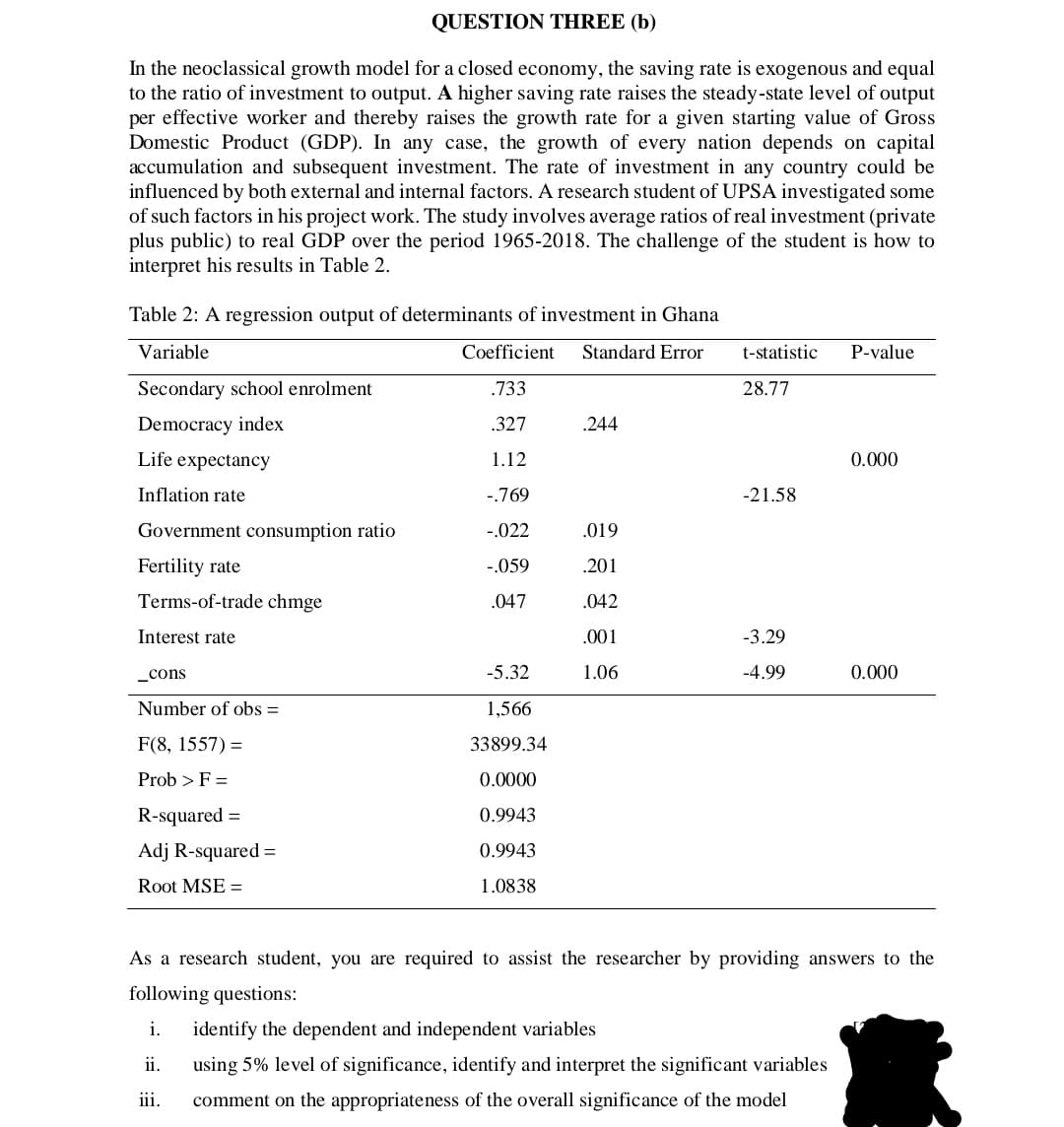In the neoclassical growth model for a closed economy, the saving rate is exogenous and equal to the ratio of investment to output. A higher saving rate raises the steady-state level of output per effective worker and thereby raises the growth rate for a given starting value of Gross Domestic Product (GDP). In any case, the growth of every nation depends on capital accumulation and subsequent investment. The rate of investment in any country could be influenced by both external and internal factors. A research student of UPSA investigated some of such factors in his project work. The study involves average ratios of real investment (private plus public) to real GDP over the period 1965-2018. The challenge of the student is how to interpret his results in Table 2. Table 2: A regression output of determinants of investment in Ghana Variable Coefficient Standard Error t-statistic P-value Secondary school enrolment .733 28.77 Democracy index .327 .244 Life expectancy 1.12 0.000 Inflation rate -.769 -21.58 Government consumption ratio -.022 .019 Fertility rate -.059 .201 Terms-of-trade chmge .047 .042 Interest rate .001 -3.29 _cons -5.32 1.06 -4.99 0.000 Number of obs = 1,566 F(8, 1557) = 33899.34 Prob > F = 0.0000 R-squared = 0.9943 Adj R-squared = 0.9943 Root MSE = 1.0838 As a research student, you are required to assist the researcher by providing answers to the following questions: i. identify the dependent and independent variables ii. using 5% level of significance, identify and interpret the significant variables iii. comment on the appropriateness of the overall significance of the model
In the neoclassical growth model for a closed economy, the saving rate is exogenous and equal to the ratio of investment to output. A higher saving rate raises the steady-state level of output per effective worker and thereby raises the growth rate for a given starting value of Gross Domestic Product (GDP). In any case, the growth of every nation depends on capital accumulation and subsequent investment. The rate of investment in any country could be influenced by both external and internal factors. A research student of UPSA investigated some of such factors in his project work. The study involves average ratios of real investment (private plus public) to real GDP over the period 1965-2018. The challenge of the student is how to interpret his results in Table 2. Table 2: A regression output of determinants of investment in Ghana Variable Coefficient Standard Error t-statistic P-value Secondary school enrolment .733 28.77 Democracy index .327 .244 Life expectancy 1.12 0.000 Inflation rate -.769 -21.58 Government consumption ratio -.022 .019 Fertility rate -.059 .201 Terms-of-trade chmge .047 .042 Interest rate .001 -3.29 _cons -5.32 1.06 -4.99 0.000 Number of obs = 1,566 F(8, 1557) = 33899.34 Prob > F = 0.0000 R-squared = 0.9943 Adj R-squared = 0.9943 Root MSE = 1.0838 As a research student, you are required to assist the researcher by providing answers to the following questions: i. identify the dependent and independent variables ii. using 5% level of significance, identify and interpret the significant variables iii. comment on the appropriateness of the overall significance of the model
Algebra and Trigonometry (MindTap Course List)
4th Edition
ISBN:9781305071742
Author:James Stewart, Lothar Redlin, Saleem Watson
Publisher:James Stewart, Lothar Redlin, Saleem Watson
Chapter10: Systems Of Equations And Inequalities
Section10.FOM: Focus On Modeling: Linear Programming
Problem 14P
Related questions
Question

Transcribed Image Text:QUESTION THREE (b)
In the neoclassical growth model for a closed economy, the saving rate is exogenous and equal
to the ratio of investment to output. A higher saving rate raises the steady-state level of output
per effective worker and thereby raises the growth rate for a given starting value of Gross
Domestic Product (GDP). In any case, the growth of every nation depends on capital
accumulation and subsequent investment. The rate of investment in any country could be
influenced by both external and internal factors. A research student of UPSA investigated some
of such factors in his project work. The study involves average ratios of real investment (private
plus public) to real GDP over the period 1965-2018. The challenge of the student is how to
interpret his results in Table 2.
Table 2: A regression output of determinants of investment in Ghana
Variable
Coefficient
Standard Error
t-statistic
P-value
Secondary school enrolment
.733
28.77
Democracy index
.327
.244
Life expectancy
1.12
0.000
Inflation rate
-.769
-21.58
Government consumption ratio
-.022
.019
Fertility rate
-.059
.201
Terms-of-trade chmge
.047
.042
Interest rate
.001
-3.29
_cons
-5.32
1.06
-4.99
0.000
Number of obs =
1,566
F(8, 1557) =
33899.34
Prob >F =
0.0000
R-squared =
0.9943
Adj R-squared =
0.9943
Root MSE =
1.0838
As a research student, you are required to assist the researcher by providing answers to the
following questions:
i.
identify the dependent and independent variables
ii.
using 5% level of significance, identify and interpret the significant variables
iii.
comment on the appropriateness of the overall significance of the model
Expert Solution
This question has been solved!
Explore an expertly crafted, step-by-step solution for a thorough understanding of key concepts.
Step by step
Solved in 4 steps with 4 images

Recommended textbooks for you

Algebra and Trigonometry (MindTap Course List)
Algebra
ISBN:
9781305071742
Author:
James Stewart, Lothar Redlin, Saleem Watson
Publisher:
Cengage Learning

College Algebra
Algebra
ISBN:
9781305115545
Author:
James Stewart, Lothar Redlin, Saleem Watson
Publisher:
Cengage Learning

Algebra and Trigonometry (MindTap Course List)
Algebra
ISBN:
9781305071742
Author:
James Stewart, Lothar Redlin, Saleem Watson
Publisher:
Cengage Learning

College Algebra
Algebra
ISBN:
9781305115545
Author:
James Stewart, Lothar Redlin, Saleem Watson
Publisher:
Cengage Learning